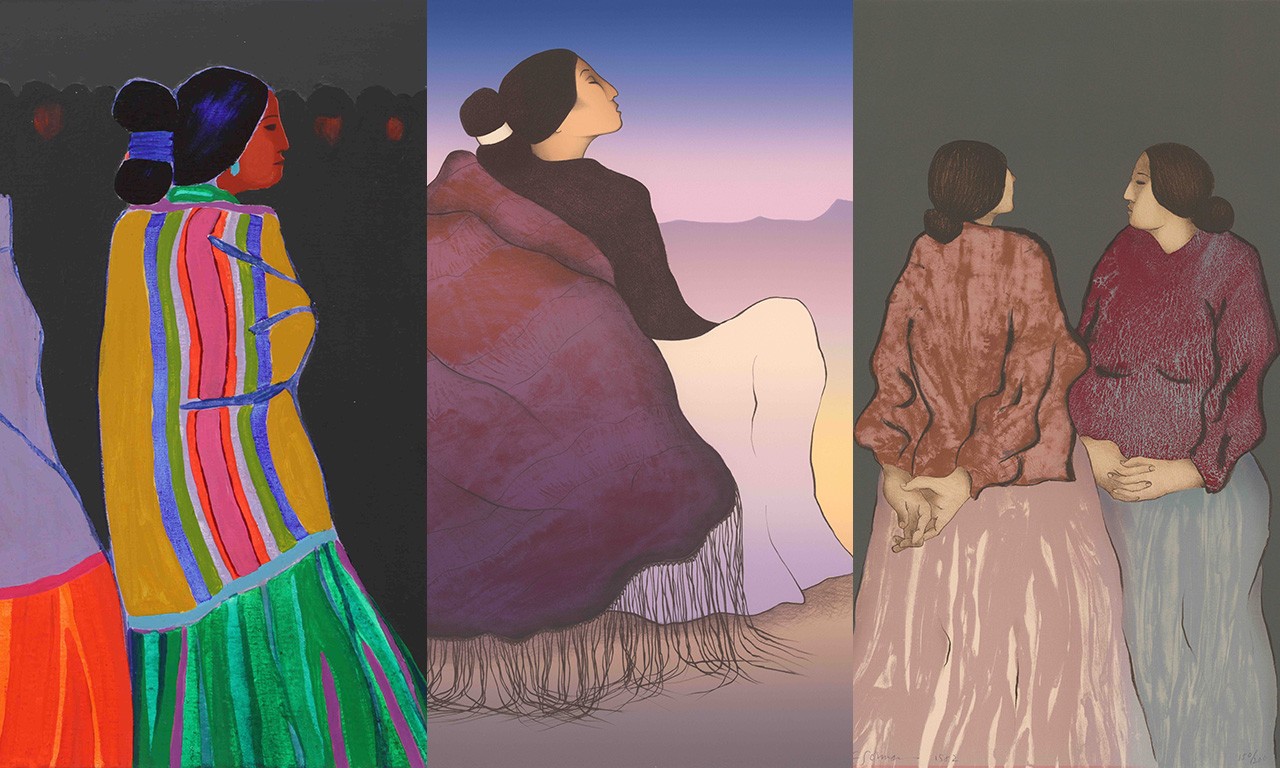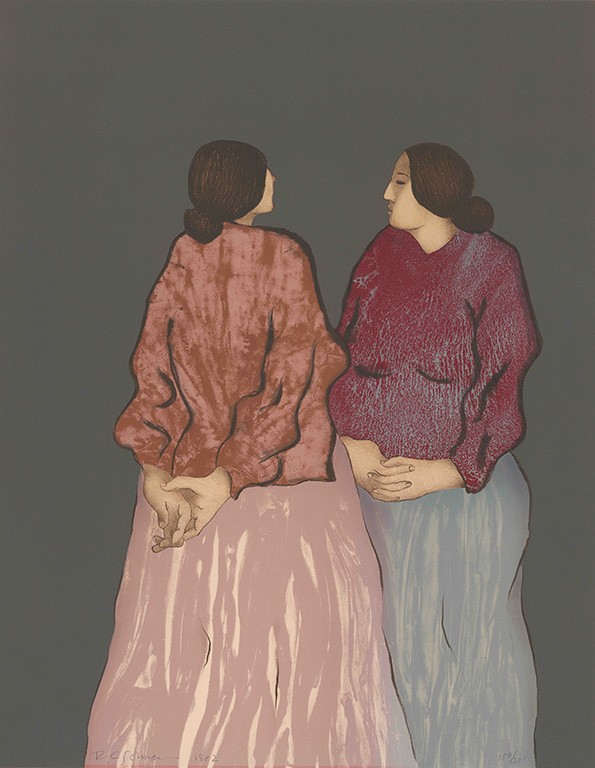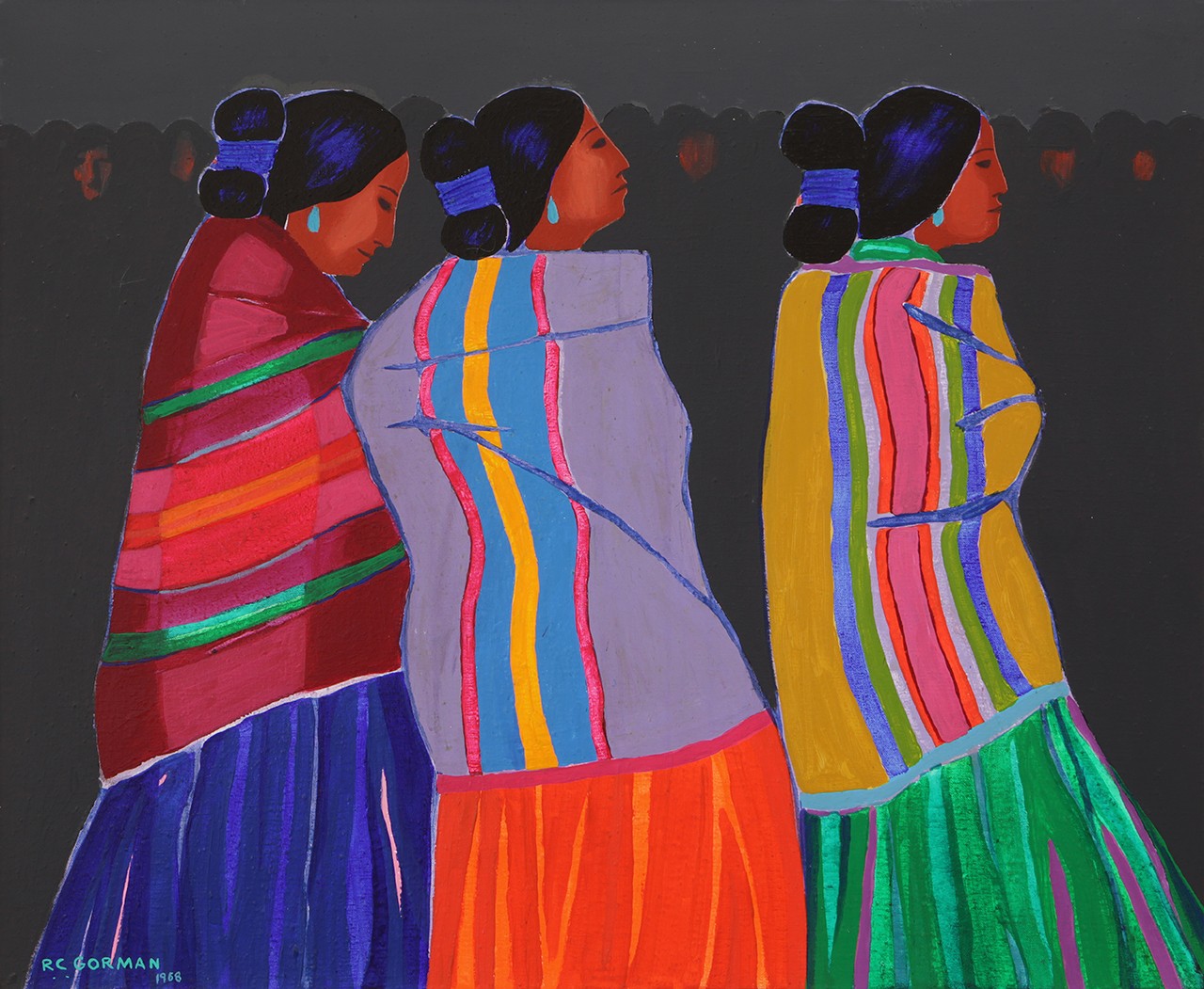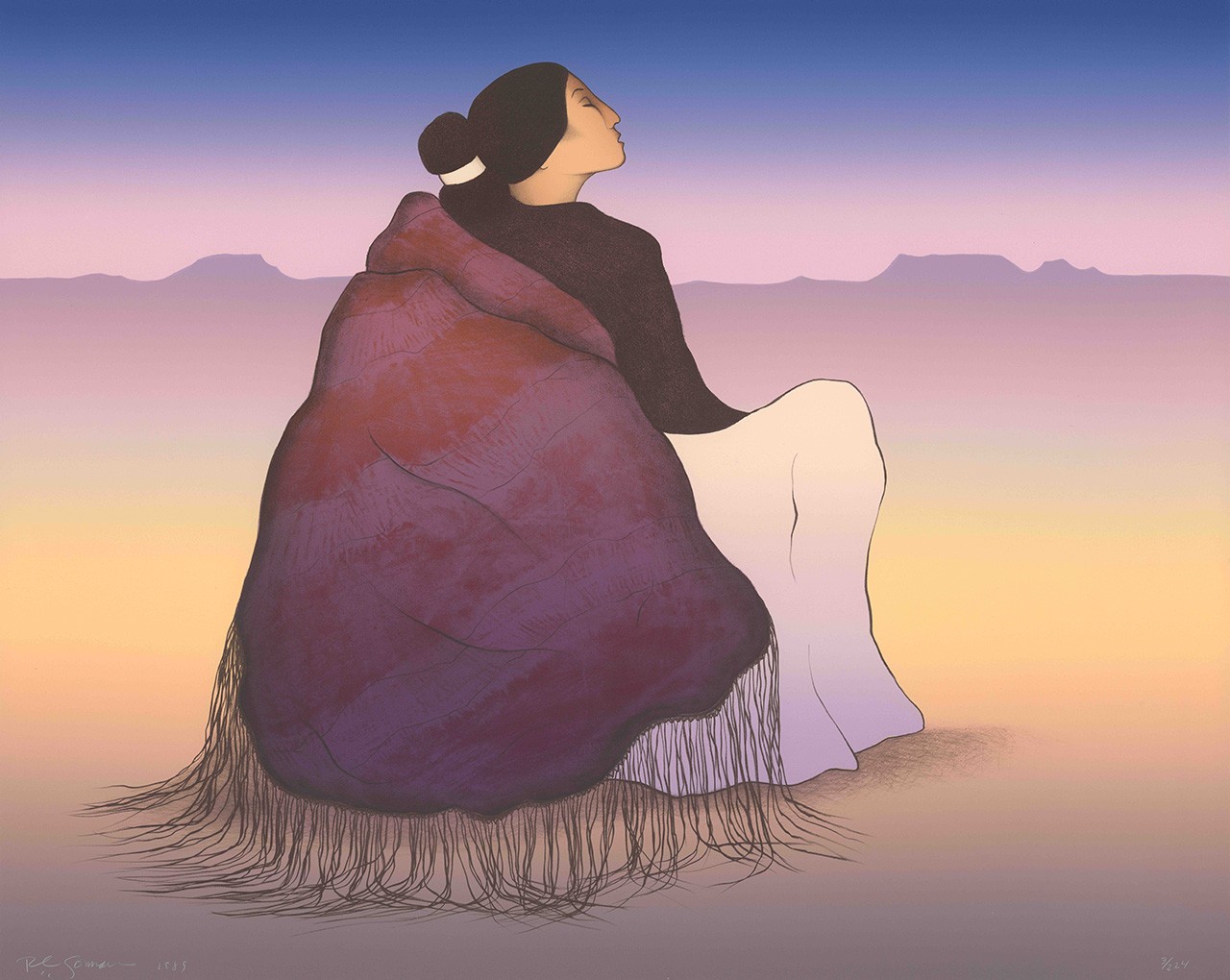 |
Details of Three Woman, Catalina de Mora, and Two Sisters
Gift from G. Stanley Alexander and Laura Alexander, 95.63.1; Gift of The Silverman Family Trust, 2024.4.9; Gift of Randie Levine-Williams, R.2013.8.3
|
In its mission to enrich lives through the world’s finest arts and cultures, Bowers Museum actively collects objects through purchases and by accepting donations from generous individuals and institutions. This Bowers Blog marks the very first entry in the New Acquisition series, focusing on the prestigious artistic career of R.C. Gorman (Diné (Navajo), 1931-2005), and the recent gift of Catalina de Mora, which joins several of Gorman’s artworks in our permanent collection.
Rudy’s Roots
Rudolph Carl Gorman was born on July 26th, 1931, to their father, Carl Nelson Gorman, and to their mother, Adele Brown, in Chinle, Arizona—a Diné community nestled near the mouth of Canyon de Chelly. Raised in a traditional hogan surrounded by members of their extended family and herding sheep, Gorman’s childhood was steeped in Native culture. Their father was an accomplished artist himself and served as a Navajo code talker during World War II, while their mother was responsible for the household and a devout Catholic.
From Hogan to Art Gallery
Like many young Diné boys of the era, Gorman was sent to Catholic boarding school. For some time, they attended Saint Michael’s Catholic School, and later transferred in the fall of 1944 to Ganado Presbyterian Mission School, where bilingual instruction and supportive teachers fostered the young Gorman’s creative talents. Gorman graduated from Ganado Mission Highschool in 1950 and briefly studied literature and art at Arizona State College (now Northern Arizona University) before enlisting in the Navy less than a year later at the tender age of 19—henceforth, adopting the initials R.C.
Upon discharge, the Navajo Tribal Council awarded Gorman a scholarship to study art abroad for a year. During that time, they attended Mexico City College (now the University of the Americas) and later San Francisco State College. Though Gorman never actually met the Los Tres Grandes (Diego Rivera, José Clemente Orozco, David Alfaro Siqueiros), their social-realist influences are very much apparent in Gorman’s subject matter and in their modern Native style, which rebelled against the staid classical aesthetics perpetuated by “Indian” art schools at the time. Over the years, Gorman developed a highly commercial formula for his success, appearing in as many as 10 shows a year. In 1968, Gorman moved with their partner, Clifton Koltz, to Taos, New Mexico, where together they established the first Native-owned art gallery in the United States, the R.C. Gorman Navajo Gallery, and where the artist produced art until their passing in 2005 at the age of 74.
 |
R.C. Gorman
Diné, 1931-2005
Two Sisters
1982
Paper and ink, 28 3/4 x 34 1/2 in.
Gift of Randie Levine-Williams, R.2013.8.3 |
Woman as Mirror and Muse
Of the Gorman works in Bowers permanent collection, Two Sisters is quintessential of Gorman’s depictions of graceful and robust Native women dressed in traditional wear in scenes of daily life, for which the artist is celebrated. The ink illustration depicts two sisters engaged in quiet dialogue, their voluptuous forms rendered in bold, fluid lines, juxtaposed by a muted gray background that foregrounds the figures. Minute details, such as the sisters’ rough, calloused hands, articulate a social-realist visual language that foregrounds the embodied and lived experiences of Native women central to Gorman’s oeuvre.
Gorman’s artistic career saw critical acclaim as well as controversy, as they balanced commercial success with a duty to their cultural roots. Perhaps overlooked because of the political climate of the era or eclipsed by their commercial success as a prodigious Indigenous artist are discussions of Gorman’s homosexuality, a vital element of the artist’s life and practice. Most biographies only pay a cursory glance to the time Gorman spent between 1955 and 1968 immersing themself in the burgeoning gay mecca of San Francisco and the city’s bohemian art scenes and subcultures, which undoubtedly played a large role in nurturing Gorman’s interdisciplinary artistic ethos and in unleashing their sexuality.
According to Jordan Biro Walters in the 2019 article So Let Me Paint: Navajo Artist R.C. Gorman and the Artistic, Native, and Queer Subcultures of San Francisco, California, in private letters to John Manchester—a close friend and one of, if not, the artist’s greatest patron—Gorman often referred to themself as a woman. Walter elucidates that Gorman moved fluidly between genders in their performativity and that they viewed the act of wearing Native clothing outside of the reservation as not so dissimilar from drag performance—to that effect, embodying new meaning as a hybrid expression of both Indigeneity and queer identity.
 |
|
R.C. Gorman
Diné (Navajo), 1932-2005
Three Women
late 20th century
Oil on canvas, 28 3/4 x 34 1/2 in.
Gift from G. Stanley Alexander and Laura Alexander, 95.63.1
|
The painting, Three Women, depicts three Native women walking side by side as a crowd looks on, each woman enveloped in vibrant Native clothing. In the dark, ambiguous background, abstract faces rendered in red can just barely be made from the silhouettes formed from the juxtaposition between the slightly darker background and the figures. Based on this revelation about Gorman’s homosexuality, Gorman’s Native women become introspective sites for the convergence of Native heritage, gender performativity, and the artist’s own queer identity. Viewing themself in each of the women they depicted, Gorman illustrated powerful and beautiful Native women as an outlet to explore their own gender and sexuality disguised within a familiar, Native vernacular, as it would likely have been very difficult for him to publicly express their homosexuality both on the reservation and to the American public.
 |
|
R.C. Gorman
Diné (Navajo), 1932-2005
Catalina de Mora
1989
Lithograph, 29 3/4 x 37 3/16 in.
Gift of The Silverman Family Trust, 2024.4.9
|
Last but certainly not least, the recent gift of Catalina de Mora joins Two Sisters and Three Women in our growing Gorman collection at Bowers Museum. The lithograph depicts a lone, seated Native woman draped in flowing articles of Native clothing as she gazes into the horizon set against an expanse of plateaus. Catalina De Mora recalls familiar tropes and hallmarks of the artist, but it is distinct in its composition, drawing on a more somber palette of colors in rendering the ancestral lands of the Diné people. Soft hues of purple, yellow, blue, and pink form the incandescent horizon that becomes yet another site where Gorman’s entwined narratives of Diné heritage and queer identity converge, inviting viewers to witness the dialogue between the Native woman before us, the land, gender, sexuality, and self.
Text and images may be under copyright. Please contact Collection Department for permission to use. References are available on request. Information subject to change upon further research.





Comments 1
Don't understand who else is referred to in the article about the artist, but the paintings are magical and must be spectacular when viewed.